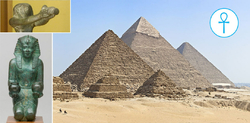- Retour accueil
- Vous êtes ici : Blog The Pyramids of the Cold The Pyramids of the Cold Section 31 • Hapi's twin brother Hapy and the seven scorpions
The Pyramids of the Cold Section 31 • Hapi's twin brother Hapy and the seven scorpions
Publié par Bruno Coursol dans The Pyramids of the Cold le 05/03/2023 à 17:26
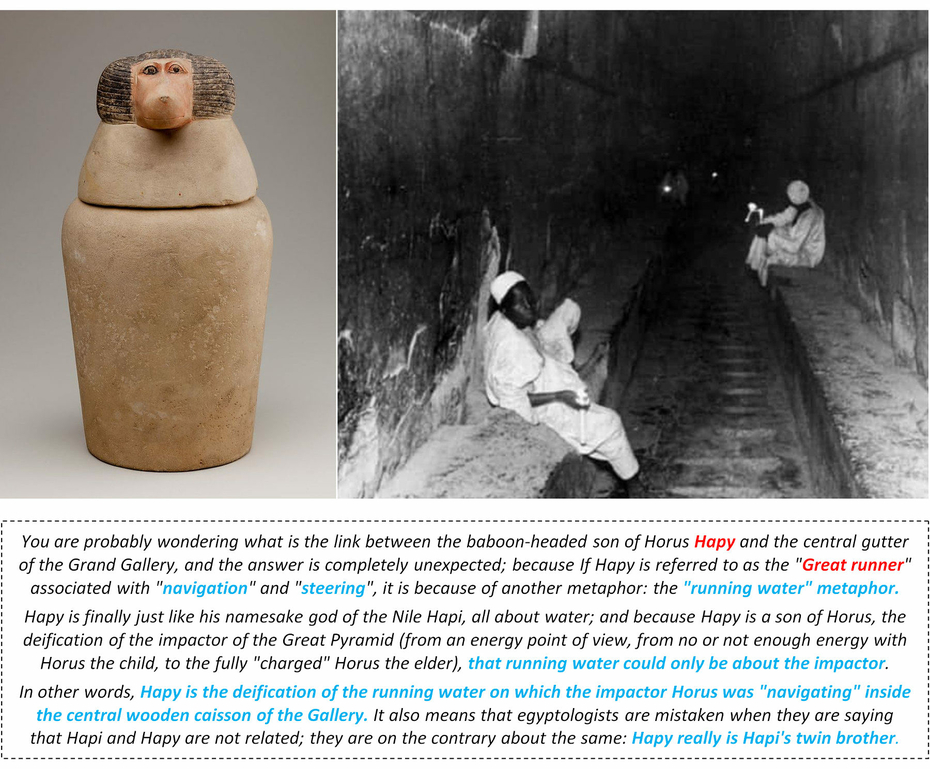
Canopic Jar representing the deity Hapy 664–525 BC (late period), from the Metropolitan Museum of Art, New-York https://www.metmuseum.org/art/collection/search/543953
The Pyramids of the Cold Section 31 • Hapi's twin brother Hapy and the seven scorpions of Isis
In summary: the assumption I've been making that the Hauling beetle of the Great Pyramid was operated by a team of 8 crewmembers working inside the wooden gantry, was wrong. Two things are actually pointing to that understanding: first the deciphering of Hapy, the baboon-headed Son of Horus, who was called "the Great Runner" because of the "running water" metaphor, and second because of the myth about Isis and the seven Scorpions.
1 • The extreme similarity of the names of the god of the Nile "Hapi" and the baboon-headed son of Horus "Hapy" isn't accidental at all, because they are actually both metaphors of the way that the Nile river is wandering around Egypt. If son of Horus Hapy has been referred to as the "Great Runner" and associated with the idea of "stirring" and "navigation" it is because of the "running water" metaphor: Hapy is the deification of the "little Nile" that was wandering into the central caisson of the Grand Gallery and by doing so, allowing the impactor Horus to gain speed and energy before becoming Medjed "the Smiter" and pressurizing the waters of the inclined well.
In other words, Hapi and Hapy are physically the exact same thing: the water that powered up the Great Pyramid; the only difference between them is that god of the Nile Hapi is about the water in the King's chamber (Hapi's cavern) and waiting to be used, when son of Horus Hapy, is about that same water (but filtered by the sarcophagus), wandering inside the Grand Gallery and putting Horus (the Elder) into motion and giving him speed and energy. Hapy = (the running water from) Hapi. In other words: Hapy is Hapi's twin brother.
2 • If the Hapy deciphering leads to the simple truth that the sons of Horus simply aren't about the crewmembers of the Hauling beetle, there is actually one very important ancient Egyptian myth that is all about them, and that is the myth about Isis and the seven scorpions. These seven Scorpions are all about the work team of the Grand Gallery, and they are telling us that the Beetle was not operated by 8, but by 6 crewmembers; and it is all in the myth.
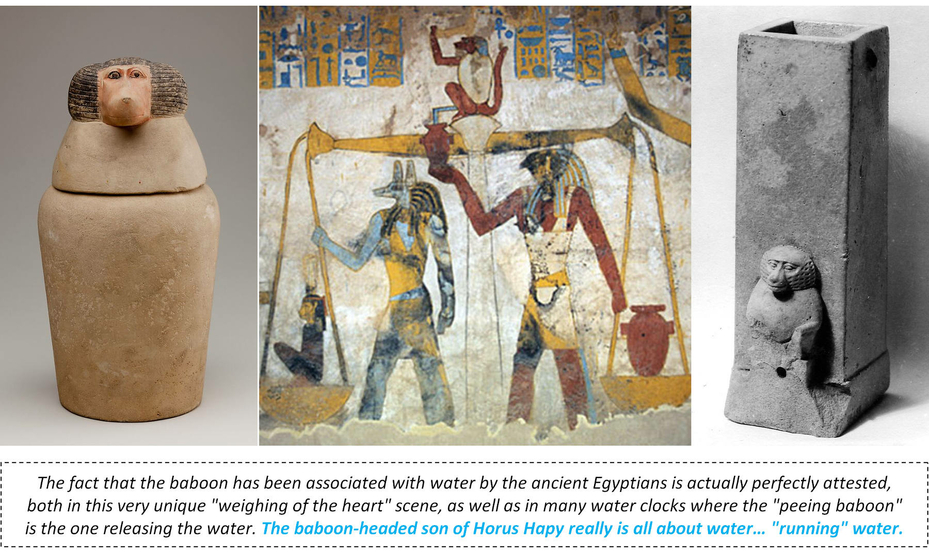
Son of Horus Hapy is indeed all about water as suggested by many water clocks: Hapy really is Hapi's twin brother.
Canopic Jar Representing the Son of Horus Hapy, at the Metropolitan Museum of Art in New-York : https://www.metmuseum.org/art/collection/search/543953
The Weighing of the Heart Justice scene ceremony in the sarcophagus chamber of the tomb of Baennentiu, Qarat Qasr Salim, el-Bahriya depression, Libyan desert, Egypt. Photograph courtesy of Roland Unger and posted on Wikipedia : "Justice scene: tomb owner Baennentiu conducted by Maat, Anubis and Horus with scales, Thoth, right wall in the sarcophagus chamber of the tomb of Baennentiu. https://upload.wikimedia.org/wikipedia/commons/3/39/BawitiSelimBanentiuSanctRight.jpg
"Clepsydra or water clock with squatting baboon", at the Metropolitan Museum of Art, New-York: https://www.metmuseum.org/art/collection/search/549190
31.01 Son of Horus Hapy really is all about god of the Nile Hapi: the similarity of their names isn't accidental at all
One more time, I really have to admit I love all these metaphors; sometimes they are just under our very eyes and we don't even understand that it really is one of them, until suddenly you simply see it… and try to understand it.
And once again, the Hapy metaphor is really so good: because son of Horus Hapy is well known to be connected with "navigation" and in the same time is referred to as the "Great Runner", seriously it doesn't take a genius to understand that the metaphor about the "Great Runner" in a "navigation" context is all about "running water", or does it?
I understand that for egyptologists, Hapy is simply the baboon-headed son of Horus we can find on many canopic jars protecting the lungs of the deceased; but the baboon is also find everywhere directly associated with water, as are proving the many water clocks found from the ancient times, as well as in a representation of the "weighing of the heart" scene, where a baboon is obviously "peeing" water into a jar.
"Hapi (Ḥpj) the baboon headed son of Horus protected the lungs of the deceased and was in turn protected by the goddess Nephthys. The spelling of his name includes a hieroglyph which is thought to be connected with steering a boat, although its exact nature is not known. For this reason he was sometimes connected with navigation, although early references call him the great runner: "You are the great runner; come, that you may join up my father N and not be far in this your name of Hapi, for you are the greatest of my children – so says Horus" https://en.wikipedia.org/wiki/Four_sons_of_Horus
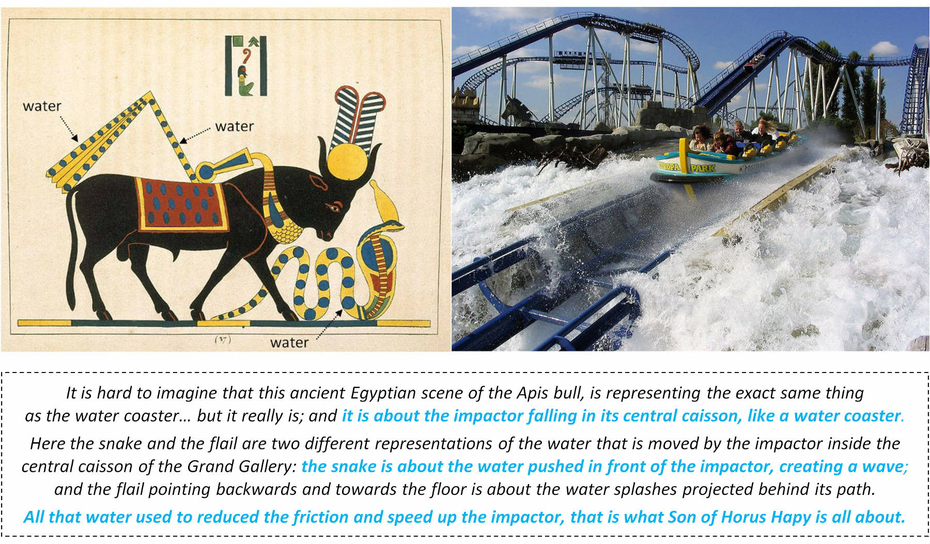
If the Hauling beetle has been glorified into many goddesses with the appearance of a cow (Hathor, Mehet-Weret, Neith and Serket), the impactor has been represented into powerful bulls, such as the Apis bull.
The Apis Bull, also Api or Hapi (Apis, Taureau Consacré a la Lune)", 1823-25, by the French illustrator Léon-Jean-Joseph Dubois, at the Brooklyn Museum: https://www.brooklynmuseum.org/opencollection/archives/image/55326
"Poseidon" water coaster at Europa-Park, by Stefan Scheer: https://en.wikipedia.org/wiki/Water_ride#/media/File:Europapark_Poseidon.jpg
31.02 The still waters of god of the Nile Hapi vs. the running waters of Hapy: the water coaster metaphor
Hapy is a Son of Horus, so the running water he is all about is the one used inside the central wooden caisson of the Grand Gallery precisely where the impactor Horus was endlessly moving up and down. That running water transformed the central gutter of the Gallery into a water slide for the impactor, and the one which was accumulating in front of the impactor, as well as on its sides.
This accumulated water is what "I have come to be your protection. I have bound your head and your limbs for you. I have smitten your enemies beneath you for you, and given you your head, eternally" is all about.
Hapy is simply the continuity of Hapi's water; they are also both another example of the ancient Egyptian philosophy opposing the active and inactive sides of all things: when the waters of god of the Nile Hapi are still in the King's chamber, the water of Hapy are active "running waters".
In Spell 151 of the Book of the Dead Hapi is given the following words to say: "I have come to be your protection. I have bound your head and your limbs for you. I have smitten your enemies beneath you for you, and given you your head, eternally." https://en.wikipedia.org/wiki/Four_sons_of_Horus
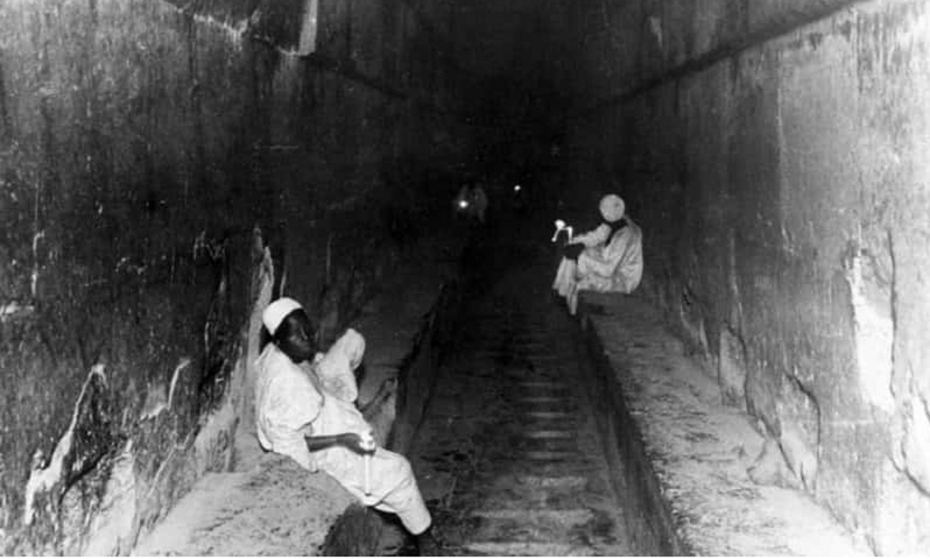
Original image of the Grand Gallery of the Great Pyramid of Egypt at Giza, built by pharaoh Khufu, from page 52 of "The call of the stars; a popular introduction to a knowledge of the starry skies with their romance and legend" (1919) by Kippax, John R. (John Robert), 1849-1922 : https://www.flickr.com/photos/internetarchivebookimages/14597229618/
31.03 Hapy (the son of Horus) represents the same waters of Hapi (the god of the Nile), but running down the Gallery
The deciphering of the baboon-headed son of Horus Hapy, the Great Runner because of the "running water" metaphor (and used in particular in ancient Egyptian water clocks associated with the baboon), as the deification of the water which was running inside the central wooden caisson of the Grand Gallery to reduce friction and accelerate the fall of the impactor, also allows us to explain why ancient Egyptians chose to use to name two "different" gods with pretty much the exact same name: Hapi and Hapy (in their occidental writing).
The baboon-headed son of Horus Hapi (Ḥpj in ancient Egyptian) vs. the god of the Nile Hapi (also Hpj)
To be honest, the ancient Egyptian writing for god of the Nile Hapi, also has an additional sign, but which isn't read properly by my computer.
https://en.wikipedia.org/wiki/Four_sons_of_Horus and https://en.wikipedia.org/wiki/Hapi_(Nile_god)
But what is important is that if both names are or sound identical or very similar is that they are about the same thing.
Remember, one of the most important errors I've made, was to think the water used to power up the Great Pyramid was coming from the Nile; I didn't see the metaphor. Because god of the Nile Hapi is like every other deity, a metaphor.
What ancient Egyptians wanted to focus on was the way the water they used was circulating inside the pyramid: from the sky they collected rain water (rainwater harvesting from the flat roof of the pyramid), which runned through the King chamber shaft(s) towards the chamber itself, then the biosand filter Khnum (and its supplying valve Satis and Anuket) where it became purified, then the Gallery from which the inclined well was supply with new water as well, then the fog nozzle, the evaporative cooling passage, the Queen's chamber and finally its shaft(s).
This entire journey of the water inside the Great Pyramid is what triggered the Nile metaphor: the water in the Pyramid behaved just like the Nile in the country.
In other words, the water running inside the central caisson of the Gallery to "sustain" the impactor Horus, was kind of a river "within" the Nile river itself. The son of Horus Hapy is all about that river which put Horus into motion; kind of a river within the river. In some way, that little river which runned through the Grand Gallery, was a perfect reduction of the great river that was the Nile, and so a perfect reduction of the metaphor of that great river.
In other words, the god of the Nile Hapi can be seen as the one giving birth to the son of Horus Hapy.
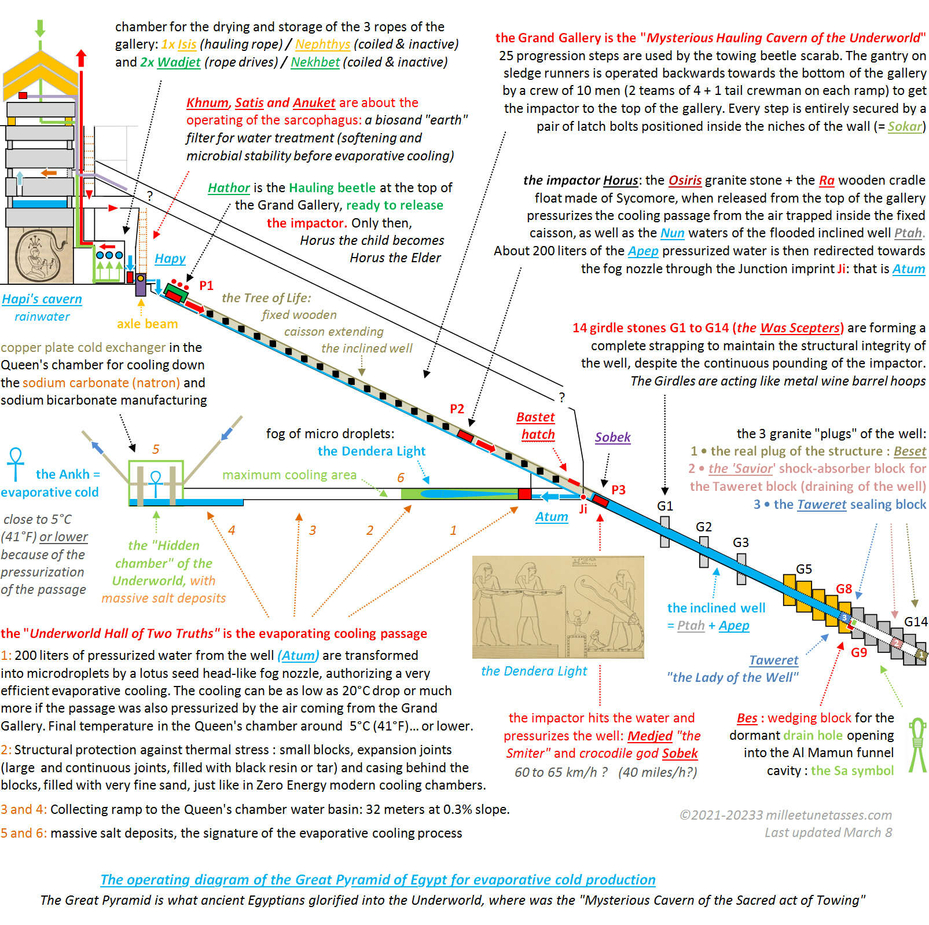
In order to create and use pressurized air, the central caisson had to function exactly like a bicycle pump: the caisson was closed and completely airtight, from top to bottom, the only access to its interior was the Bastet hatch at the bottom of the Gallery, near the mouth of the inclined well.
31.04 The operating diagram of the Great Pyramid of Egypt for evaporative cold production
Last updated February 28, 2023. Four Sons of Horus correction and implementation of the baboon-headed son of Horus Hapy as the continuity of god of the Nile Hapi. Hapy represents the Hapi filtered water, running though the Grand Gallery and allowing the impactor Horus to gain speed and energy.
Also, Hathor is not the Hauling beetle actually releasing the impactor from the top of the Grand Gallery, but the Beetle with the impactor secured and protected underneath her (the impactor is then Horus the child; the exact moment of the impactor release had been glorified into Neith (the One giving birth to Ra) and Serket (the One giving birth to Horus.
If the Hauling beetle has been glorified into many goddesses with the appearance of a cow (Hathor, Mehet-Weret, Neith and Serket), the impactor has been represented (among others) into the powerful bull, as in the Apis bull.
Hapy is simply the continuity of Hapi's water; they are also both another example of the ancient Egyptian philosophy opposing the active and inactive sides of all things: when the waters of god of the Nile Hapi are still in the King's chamber, the water of Hapy are active "running waters".
31.05 The dumbest thing to do if you see yourself as a scientist
The thing is, I knew about the myth of Isis and the seven scorpions for quite a while now, but because of the false interpretation of the Sons of Horus I've made, I completely disregarded the myth because it wasn't compatible with the hypothesis of a Hauling beetle that would have been operated by 8 crewmembers; and it was certainly the dumbest thing to do.
Instead of questioning the 8 crewmembers hypothesis, I preferred to forget every piece of data contained in the scorpions' myth; but now that I know that the Sons of Horus are nothing less than the exact same kind of metaphors we've already seen with so many gods and goddesses, that they are not about "people", I can give to these scorpions all the attention they deserve.
31.06 The myth of Isis and the seven scorpions
Excerpt from a post written by Joshua J. Mark, a freelance writer and former part-time Professor of Philosophy at Marist College, New York. https://www.worldhistory.org/Serket/
"One of the most popular stories concerning Isis is known as Isis and the Seven Scorpions. It relates how, when Horus was an infant and Isis was hiding him in the swamp lands, Serket had seven scorpions keep her company. When Isis went out to beg for food in the nearby towns, three of them - Petet, Tjetet, and Matet - would go before her to make sure the way was safe and Set was not waiting in ambush, two were on either side of her - Mesetet and Mesetetef - and two brought up the rear - Tefen and Befen, who were the most fierce - in case Set chose to attack from behind".
"Whenever she left the swamp, Isis would conceal her glory so she looked like a poor, older woman asking for alms. One night, as she and her bodyguard entered the town, a very rich noblewoman looked down on them from her window and quickly slammed her door and locked it. Serket, though watching over Horus in the swamp, could see all that her scorpions saw, and she was angered at this affront to Isis. She decided the woman would pay for the insult and sent a message to Tefen that he should take care of the situation. The other six scorpions all surrendered their poison to Tefen who drew it up into his stinger and waited for the right moment. In the meantime, a poor peasant woman had seen the noblewoman refuse hospitality and, even though she had little, offered Isis and her scorpions a place under her roof for the night and a simple meal".
" While Isis was eating with the young woman, Tefen snuck out of the house and crept beneath the door of the home of the noblewoman, where he stung her young son. The boy fell down in a stupor, and the noblewoman grabbed him up and tried to revive him but could not. She ran into the streets, crying for help, and Isis heard her. Even though the woman had refused her food and a place for the night, Isis forgave her. She did not want the boy to pay for his mother's insult. Isis took the child in her arms and called each of the scorpions by their secret name, thereby dominating them and neutralizing their power, and recited spells of great magic. The poison evaporated, leaving the child's body, and he revived. The noblewoman was so grateful and so ashamed of her earlier behavior, she offered all her wealth to Isis and the peasant woman. Serket, back in the swamp with Horus, regretted having sent the scorpion to attack the innocent boy and vowed to protect all children in the future".

It is in the two huge holes on the upper platform of the Grand Gallery where were set the axle beam drive shaft holders. The "Two Sandals" of the House of Isis are these holders (see farther down the Section).
31.07 Operating diagram of the Grand Gallery with seven crewmembers and a six-compartments Hauling beetle, P4 Side view
31.08 Isis and the seven scorpions - Deciphering part 1: the 6 crewmembers operated Hauling beetle
"It relates how, when Horus was an infant and Isis was hiding him in the swamp lands, Serket had seven scorpions keep her company." https://www.worldhistory.org/Serket/
This myth is incredible, because it is so rich; there are so many clues and so many references to the operating of the Grand Gallery that it is hard to even decide where to start. Let's try step by step, piece by piece from the above excerpt:
Horus the infant is obviously Horus the child, and we've seen that Horus (the child or the elder) is the glorification of the impactor, from an "energetic" point of view: Horus the elder has all the power needed to accomplish its tasks and he is gaining speed and energy in the Grand Gallery, when Horus the child doesn't and he is either getting to the top of the Gallery or staying put at the top, under the Beetle Hathor). Horus the child is hauled by Isis, and it all happens inside the central caisson of the Gallery. So here, the swamp lands are the central caisson. We've just seen that this caisson was, every 15 minutes or so, travelled by the running waters of Hapy so that the impactor could move in the first place.
And of course, it is the Hauling beetle which was keeping company to Horus the child: it means that the seven scorpions are the work team of the Beetle.
Obviously, there is a distinction to make between Hathor and Serket; of course they both are representations of the Beetle at the top of the Gallery, with the impactor hidden underneath, and probably Hathor is the "protecting side" of the Beetle in this particular position, when Serket would be about the cycle of hauling and releasing in its entirety.
What we learn, is that there are seven scorpions. Is it "safe" to presume that this time, it really is about the team work of the Gallery? I would say yes; the Hauling beetle of the Great Pyramid was most probably designed to accommodate six crewmembers, and there would have been an additional teammate that would have stay on the platform at all times.
I guess, some of his most important role was to secure the impactor after the hauling, and to release it on demand.
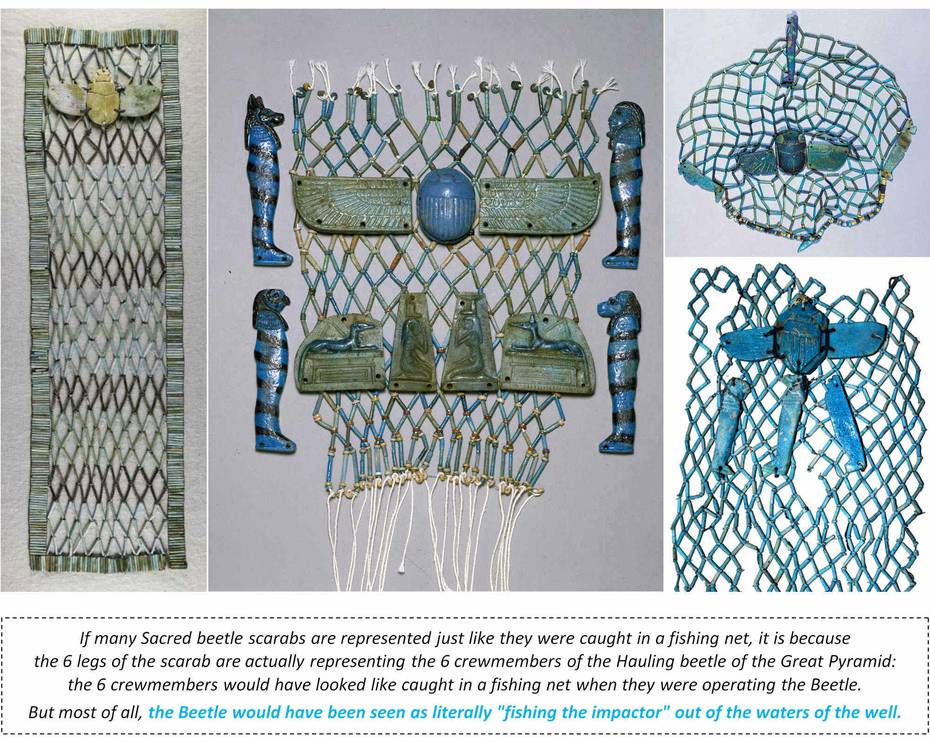
"Mummy Bead Net with Winged Scarab, Third Intermediate Period - Late Period, date 1076-332 BCE", at the Michael C. Carlos Museum in Atlanta: https://collections.carlos.emory.edu/objects/38469/mummy-bead-net-with-winged-scarab
Image from the Walters Art Museum: https://art.thewalters.org/detail/28885/amuletic-figure-of-kebehsenuef-son-of-horus/#item-modal
"Faience pectoral scarab with spread wings and bead net", Royal Pump Room, Harrogate. This file was donated by Harrogate Museums and Arts service as part of the Yorkshire: https://en.wikipedia.org/wiki/Scarab_(artifact)#/media/File:Bead_net_with_scarab_HARGM3698.JPG
"Egyptian Faience" at the Australian Museum, Sydney: https://australian.museum/learn/cultures/international-collection/ancient-egyptian/egyptian-faience/
31.09 It is the 6 legs Sacred Beetle Scarab which is really caught in Sobek's net
I've thought in previous Section 30, that the famous "net of Sobek" was all about the Four Sons of Horus, and that is what tricked me in the deciphering of these Sons of Horus: they are not about the crewmembers, as I've already explained in this Section; at least one of them is about the water running inside the caisson, and I suspect that the three other sons of Horus, also are about water, as they are often represented "getting out" of a lotus flower.
But, if you look at the above images of nets, of course some of them are showing the Sons of Horus (water was everywhere in or around the Grand Gallery), but what is always here, caught in the nets is the sacred beetle scarab. In other words, if the Beetle is the One caught inside the net, it is because it really is the net: it is the net in which the crewmembers of the Beetle were caught.
If the Sacred beetle scarab is represented caught in a fishing net, it is because its 6 legs are actually the 6 crewmembers of the Hauling beetle, and these crewmembers looked like caught in a fishing net when they were all together operating the Beetle.
31.10 The Hauling beetle was literally "fishing the impactor out of the inclined well waters"
Just like there is no such thing as the barque of Ra (because Ra is the barque, i.e. the wooden part of the impactor), there is no such thing either as the fishing net and the scarab beetle: both are the same thing. Both are metaphoric representations of the Hauling beetle, either because of the way the crewmembers would have looked like onboard, or because it moved and behaved like a beetle, going backwards, with 3 pairs of legs.
The second meaning of the fishing net, is of course because the Hauling beetle itself was literally "fishing" the impactor out of the inclined well waters.
What is fascinating in the first above image of the "Mummy Bead Net with Winged Scarab" at the Michael C. Carlos Museum in Atlanta, is that the Beetle had been represented at the very top of what really looks like the shape of the Grand Gallery itself. In other words, in this fantastic artifact, we have both the "murder weapon" and the "crime scene" of what it is really representing.
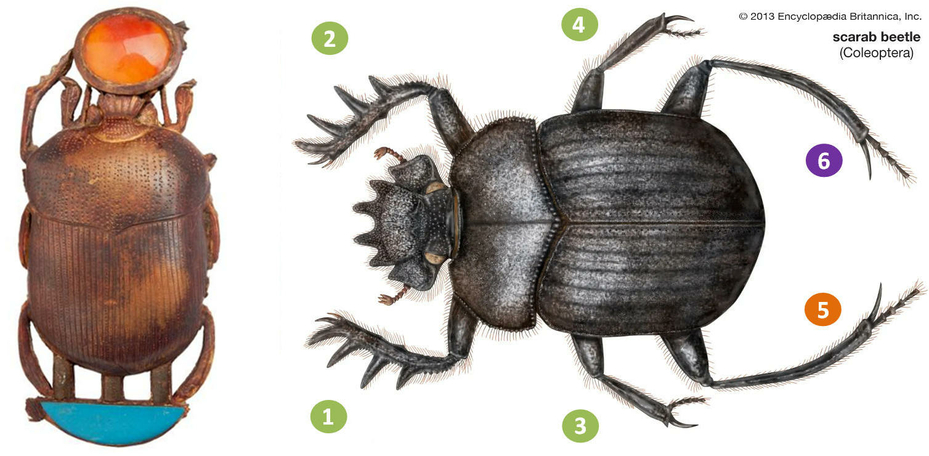
Soutpansberg Dung Beetle (Scarabaeus schulzeae), a Soutpansberg Endemic, thanks to Ryanvanhuyssteen: https://en.wikipedia.org/wiki/Scarabaeus#/media/File:Soutpansberg_Dung_Beetle_(Scarabaeus_schulzeae).jpg
Sacred scarab beetle © Encyclopædia Britannica, Access date 3 mars 2023: https://www.britannica.com/animal/scarab-beetle#/media/1/526654/139393
31.11 The beetle scarab doesn't have 8 but 6 legs like every other insect
When I believed that the Beetle was made for 8 crewmembers, I didn't make just one big mistake: I actually made another one; because what I know for sure about what ancient Egyptians created, is that nothing was done approximately. Everything that was done in science, architecture or "religious" glorification was profoundly thoughtful, and they simply never would have glorified the Hauling beetle into the scarab amulets if the original Beetle had not 6 but 8 legs.
So, I'm glad that Hapy came into play and made me see through these big mistakes.
Anyhow, and unless I'm being a simple fool again, I think we can honestly count on a Hauling beetle operated by 3 pairs of crewmembers, just like the beetle scarab has 3 pairs of legs as well.
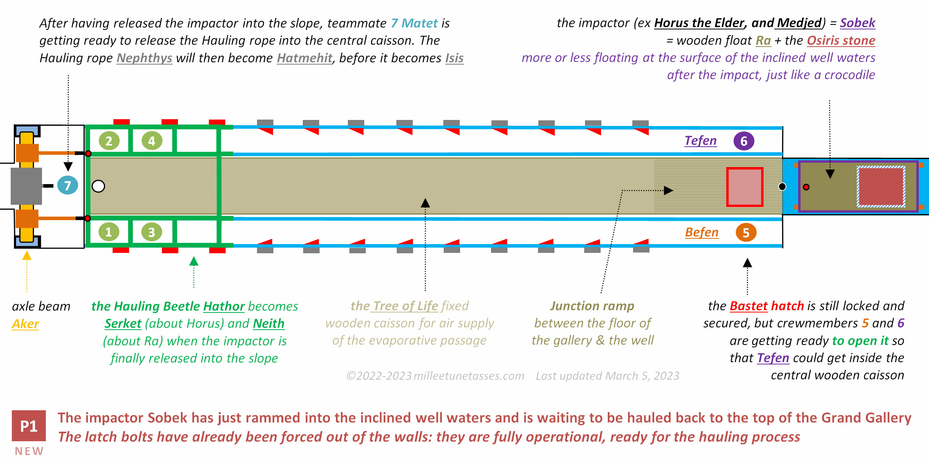
31.12 Operating diagram of the Grand Gallery with seven crewmembers and a six-compartments Hauling beetle, P1
Contrary to the previous 8 positions of the Hauling cycle, P1 is now when the impactor is floating in the inclined well after it has rammed into its waters, instead of the moment when the impactor is released from the top of the Grand Gallery.
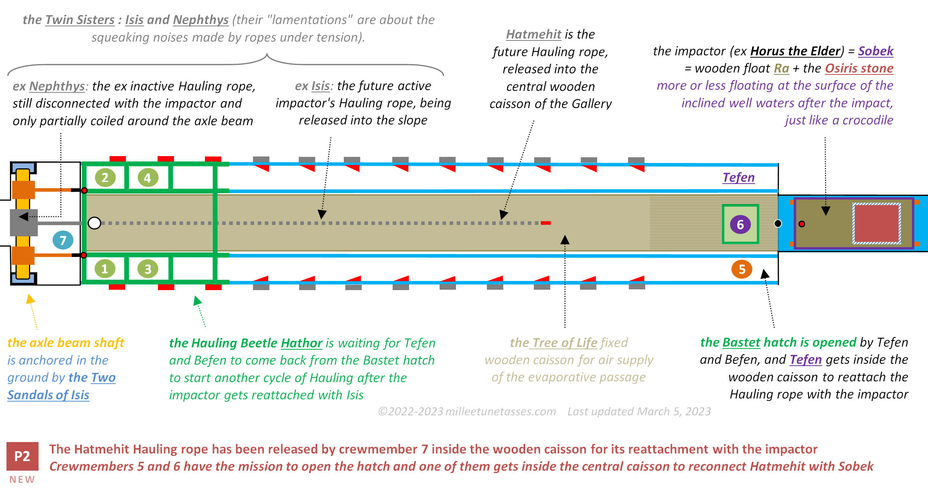
31.13 Operating diagram of the Grand Gallery with seven crewmembers and a six-compartments Hauling beetle, P2
31.14 Isis and the seven scorpions - Deciphering part 2: Tefen passing through the opened Hatch
"One night, as she and her bodyguard entered the town, a very rich noblewoman looked down on them from her window and quickly slammed her door and locked it. Serket, though watching over Horus in the swamp, could see all that her scorpions saw, and she was angered at this affront to Isis. She decided the woman would pay for the insult and sent a message to Tefen that he should take care of the situation. The other six scorpions all surrendered their poison to Tefen who drew it up into his stinger and waited for the right moment." https://www.worldhistory.org/Serket/
Here, the situation changed: Isis isn't begging anymore (fully coiled and drying out onto the platform), she is accompanying the serpents into town (the caisson); it means that at that exact moment Isis had become Hatmehit, the Hauling rope which is released into the caisson for its reattachment with the impactor (Section 27.37).
This part is actually all about Position 2 of the Hauling cycle. When it is said that Serket (the Hauling beetle at the top of the Gallery) is "watching over Horus in the swamp", it should be added that it happens from a distance, because at some point Serket "send" a message to Tefen to take action and defend Isis. In other words, while Serket is at the top end of the Gallery, the impactor Horus is at the other end (and actually it had become Sobek, floating in mid waters just like a crocodile, see previous Section 30).
We've seen that the central wooden caisson wasn't optional because the moist air of the evaporative cooling passage absolutely needed to be replaced with new dry air for the cycle to continue again and again, and we've also seen that this caisson also had to have a hatch at its bottom end so that the impactor could be reattached with the Isis Hauling rope.
The closed and locked hatch that have to sustain the pressurized air caused by the fall of the impactor, and which needs to be opened up in Position 2, so that one teammate would have to get in and proceed to the reattachment of the impactor, all this operation of the Bastet hatch (Section 27), is what the passages "a very rich noblewoman looked down on them from her window and quickly slammed her door and locked it" and "She decided the woman would pay for the insult and sent a message to Tefen that he should take care of the situation." is all about.
The teammate of the Grand Gallery who is getting inside the central wooden caisson through the Bastet hatch, that is Tefen (crewmember 6 in the diagrams).
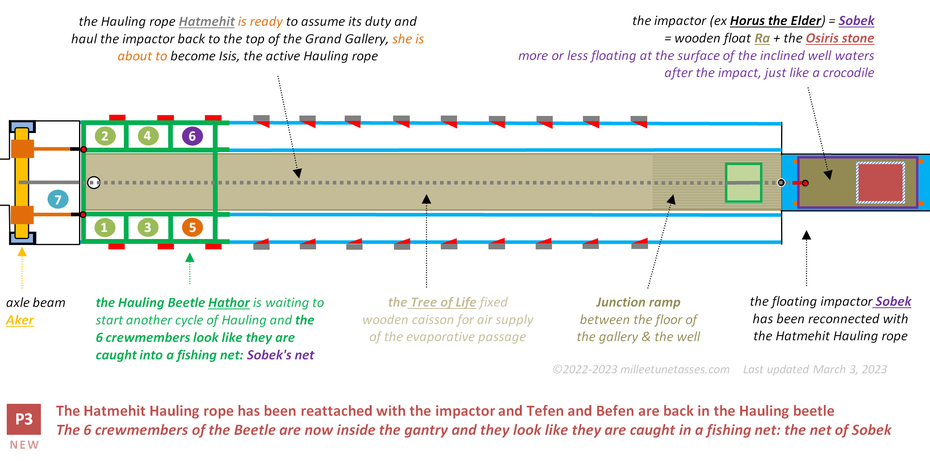
31.15 Operating diagram of the Grand Gallery with seven crewmembers and a six-compartments Hauling beetle, P3

More on the "Tresses of Nephthys", the Isis and Nephthys "Twin Sisters" and the metaphor of their "lamentations" in Section 23 and Section 25
31.16 The Tresses of Nephthys
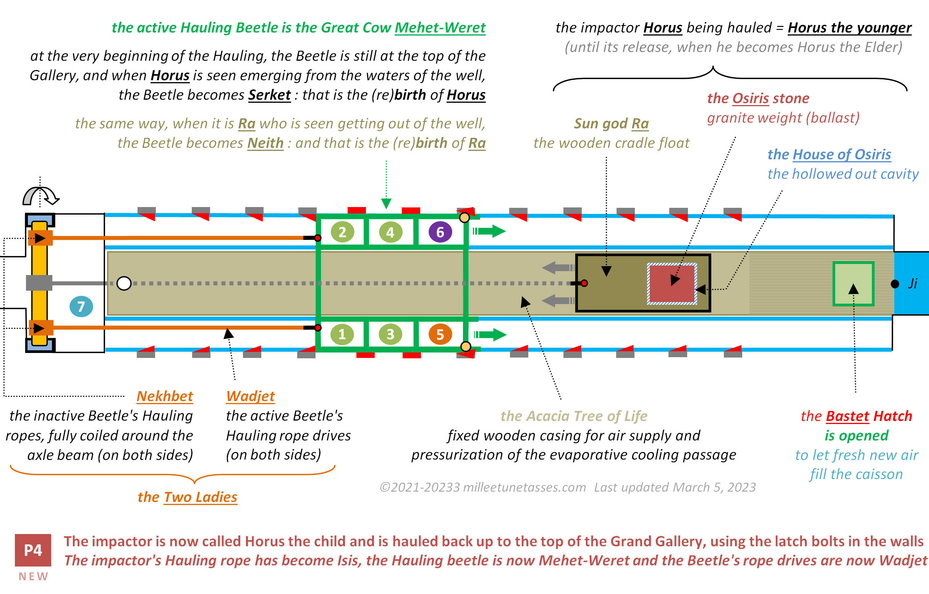
31.17 Operating diagram of the Grand Gallery with seven crewmembers and a six-compartments Hauling beetle, P4
31.18 Isis and the seven scorpions - Deciphering part 3: the recovery of the impactor
"While Isis was eating with the young woman, Tefen snuck out of the house and crept beneath the door of the home of the noblewoman, where he stung her young son. The boy fell down in a stupor, and the noblewoman grabbed him up and tried to revive him but could not. She ran into the streets, crying for help, and Isis heard her. Even though the woman had refused her food and a place for the night, Isis forgave her. She did not want the boy to pay for his mother's insult. Isis took the child in her arms and called each of the scorpions by their secret name, thereby dominating them and neutralizing their power, and recited spells of great magic. The poison evaporated, leaving the child's body, and he revived." https://www.worldhistory.org/Serket/
This part may well be the climax of the myth. First there is again Tefen who "crept beneath the door" of the home of the noblewoman, and by doing so literally replicating crewmember 6, passing through the hatch of the caisson. Then Tefen is "stinging" the young boy, who becomes inert; and that is pretty close to what really happened inside the caisson; because to the question as to know whether the impactor was really floating at the surface of the inclined well waters, or whether it was more like in mid waters, we may have the answer now: we've already seen that this second "mid waters" hypothesis was probable because of the deification of the impactor as a crocodile once in the well, an animal who loves to stay hidden in shallow waters, and if the impactor was indeed in this position in the well, most probably Tefen would have needed a tool to get him back; with that tool in his hand, Tefen would have looked like he was going to kill the crocodile impactor… or the young boy.
Then, we have the Isis "embrace" metaphor; an easy one as this part of the story here is all about the recovery of the impactor; about its reattachment with the Isis rope.
Finally, once the Isis rope is reconnected with the impactor, it is time to ask for the work team to start the Hauling process: "Isis took the child in her arms and called each of the scorpions by their secret name, thereby dominating them and neutralizing their power, and recited spells of great magic. The poison evaporated, leaving the child's body, and he revived."
Of course, I couldn't miss the mention of the "evaporated" poison: that is particularly amusing, considering the fact that the whole thing was precisely about the evaporative process.

31.19 Isis and the seven scorpions - Deciphering part 4: the Two "anchoring" Sandals of Isis are the axle beam holders
This is another text, from "Ancient Egyptian Legends, by M. A. Murray (1920)": https://www.sacred-texts.com/egy/ael/ael09.htm
"I am Isis, the great Goddess, the Mistress of Magic, the Speaker of Spells. I came out of my house which my brother Set had given to me, for Thoth called to me to come, Thoth the twice great, mighty of truth in earth and in heaven. He called, and I came forth when Ra descended in glory to the western horizon of heaven, and it was evening.
And with me came the seven scorpions, and their names were Tefen and Befen, Mestet and Mestetef, Petet, Thetet, and Matet. Behind me were Tefen and Befen; on either side were Mestet and Mestetef; in front were Petet, Thetet, and Matet, clearing the way that none should oppose or hinder me. I called aloud to the scorpions, and my words rang through the air and entered into their ears, "Beware of the Black One, call not the Red One, look neither at children nor at any small helpless creature."
Then I wandered through the Land of Egypt, Tefen and Befen behind me, Mestet and Mestetef on either side of me, Petet, Thetet, and Matet before me; and we came to Per-sui, where the crocodile is God, and to the Town of the Two Sandals, which is the city of the Twin Goddesses."

Again, there are so many informations here… I'm gonna start with the end because it really is extraordinary and it also literally set the place. And that place is the Grand Gallery; from the top end where are the platform and the axle beam (that is the "city of the Twin Goddesses [Isis and Nephthys]), to the mouth of the inclined well ("Per-sui", where the crocodile is God [that is Sobek floating in the waters of the well]).
We also learn that in between these two landmarks, is the entire "Land of Egypt", but most of all, we learn that the "city of the Twin Goddesses", i.e. the home of Isis and Nephthys, in other words the place they go to rest (the axle beam), is also called "the Town of the Two Sandals"; and that is the extraordinary part I'm talking about, because these Two Sandals, next to the axle beam, they are about the holders of the axle beam.
The metaphor here is about "anchoring": it is about having "both feet on the ground".
The same way sandals are anchoring your body to the ground, the two axle beam holders were anchoring Isis and Nephthys into the ground as well. The Sandals are about the axle beam holders. Sandals are what is anchoring your feet onto the ground; the holders are these anchors.
Line art drawing of a sandal, by Pearson Scott Foresman: https://fr.wikipedia.org/wiki/Sandale#/media/Fichier:Sandal_3_(PSF).svg
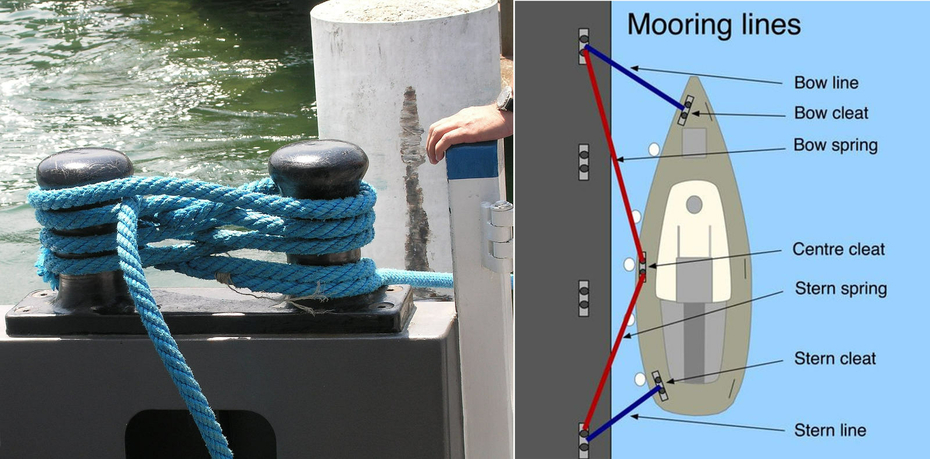
Mooring posts by Audriusaat: https://www.wikiwand.com/da/Fort%C3%B8jning#Media/Fil:Mooring2HPoleFixed.jpg
Mooring lines draw at: https://www.safe-skipper.com/competent-crew-skills-mooring-lines/
31.20 Isis is known as the "Great Mooring Post" and when she eventually located Osiris’s body after his death, she is also the one who "moored her brother" Osiris
The fact that Isis is really all about ropes and anchoring to the ground, and that she literally also used a rope to get Osiris back after his death, is actually very well known:
• Isis was called the "Great Mooring Post" in some ancient Egyptian texts: "Isis is not just about rebirth and sunrise. She is also the Great Mooring Post". https://isiopolis12.rssing.com/chan-10218340/all_p4.html
• "When Isis eventually located Osiris’s body after his murder by Seth, she “moored her brother” can be find in a very detailed study, called "When Isis "Moored" Osiris", by L. D. Graham - JEOL. There is an excerpt: "The present paper, which is philological in nature, addresses a central event in the Osiris myth as it is narrated in the Great Hymn on the Stele of Amenmose. Specifically, the Great Hymn says (in line 15) that, when Isis eventually located Osiris’s body after his murder by Seth, she “moored her brother”. https://hcommons.org/deposits/objects/hc:47012/datastreams/CONTENT/content
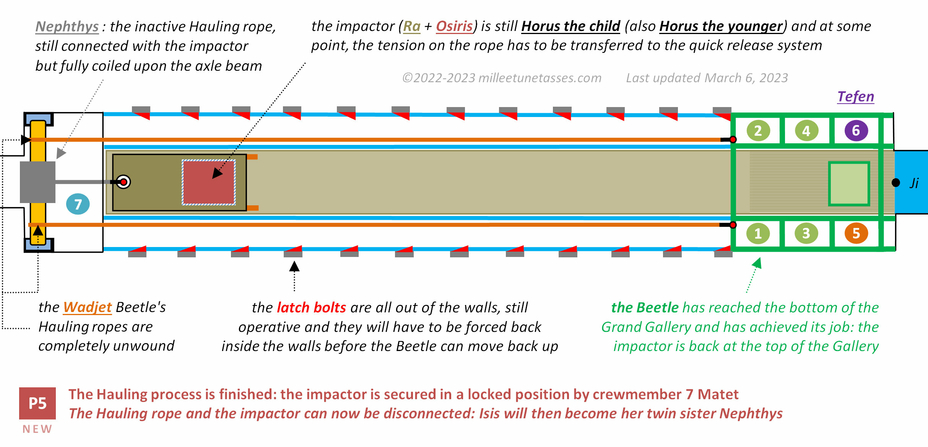
31.21 Operating diagram of the Grand Gallery with seven crewmembers and a six-compartments Hauling beetle, P5
31.22 Isis and the seven scorpions - Deciphering part 5: the names of the crewmembers
"I am Isis […] I came out of my house […] and with me came the seven scorpions, and their names were Tefen and Befen, Mestet and Mestetef, Petet, Thetet, and Matet. Behind me were Tefen and Befen; on either side were Mestet and Mestetef; in front were Petet, Thetet, and Matet, clearing the way that none should oppose or hinder me." https://www.sacred-texts.com/egy/ael/ael09.htm
The fact that we know all the names of the seven scorpions is evidently extremely valuable, but what would be even more valuable, is to know every crewmember by his name, individually.
We already know that crewmember 6 is Tefen, the one getting inside the caisson; hence we know that Befen is completing the third pair. The problem now is to interpret this part of the myth to decipher all the other ones.
I have no doubt that there are many ways to interpret the excerpt, and to try to determine if what is described is close or not to one particular position in the Hauling cycle, but maybe it is even not really rightful to see it that way, as we've already seen that ancient Egyptians loved to both demonstrate and hide their accomplishments.
My assumption is that the scorpions are named in the exact order as they were in the Beetle:
• crewmembers 5 and 6 were Tefen and Befen
• crewmembers 3 and 4 were Mestet and Mestetef
• crewmembers 1 and 2 were Petet and Thetet
• the seventh teammate of the work team was Matet, the last to be named.

"Tendre la main au sens propre comme au sens figuré", by Honoré Daumier (France, Marseille, 1808-1879). LACMA, Los Angeles County Museum of Art: https://fr.wiktionary.org/wiki/tendre_la_main_%C3%A0#/media/Fichier:'Le_Flot_qui_la_porta...'_LACMA_M.91.82.276.jpg and https://collections.lacma.org/node/203097
Supply ratings handling a coil of 16 inches (410 mm) towing hawser (rope) at the Royal Navy's Naval Stores Department, Nore, Harwich. Royal Navy official photographer, Russell, J E (Lt) - This is photograph A 16341 from the collections of the Imperial War Museums: https://en.wikipedia.org/wiki/Hawser
31.23 Isis and the seven scorpions - Deciphering part 6: the drying out and begging Isis Hauling rope
"When Isis went out to beg for food in the nearby towns, three of them - Petet, Tjetet, and Matet - would go before her to make sure the way was safe and Set was not waiting in ambush, two were on either side of her - Mesetet and Mesetetef - and two brought up the rear - Tefen and Befen, who were the most fierce - in case Set chose to attack from behind. Whenever she left the swamp, Isis would conceal her glory so she looked like a poor, older woman asking for alms." https://www.worldhistory.org/Serket/
This part is obviously the chore of the myth, and the first thing to talk about is Isis leaving the swamp, concealing her glory to resemble to a poor and old begging woman; that part is when the Hauling rope (Isis) is taken out of the central wet caisson (the swamp) and becomes Nephthys, the twin sister of Isis who was about the Hauling rope completely coiled upon the axle beam, drying out and with its end hanging out from the rest of the rope. That is what the old begging woman metaphor is all about.
Coiled upon the axle beam, and all dried out, with its end hanging out, Isis would have looked exactly like that poor old begging woman, stretching her hand for food.
The second thing is that while Isis was begging and drying out onto the platform of the Grand Gallery, the scorpions left her in a very meticulous pattern or sequence: Tefen and Befen who "brought up the rear", Mesetet and Mesetetef on "either side" of her, Petet, Tjetet and Matet who made sure the way was safe. These are the names of the seven teammates of the Grand Gallery's work team.
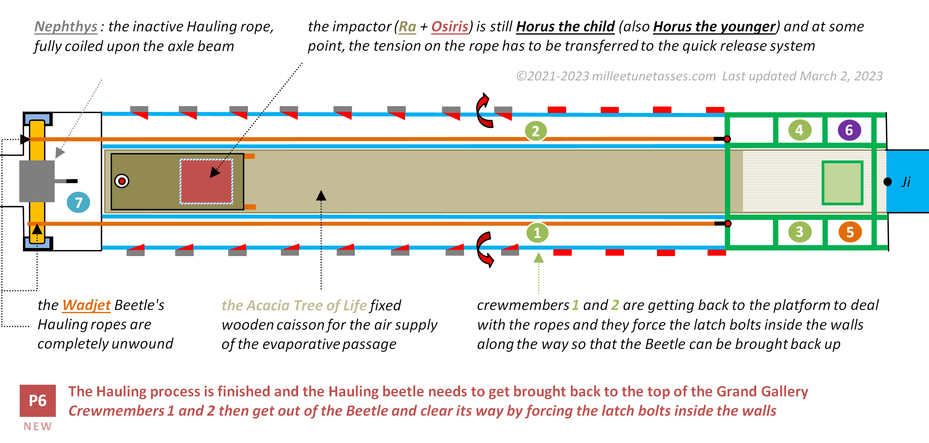
31.24 Operating diagram of the Grand Gallery with seven crewmembers and a six-compartments Hauling beetle, P6
"When Isis went out to beg for food in the nearby towns, three of them - Petet, Tjetet, and Matet - would go before her to make sure the way was safe and Set was not waiting in ambush, two were on either side of her - Mesetet and Mesetetef - and two brought up the rear - Tefen and Befen, who were the most fierce - in case Set chose to attack from behind".
Petet, Tjetet and Matet are crewmembers 1, 2 and 7.
31.25 Isis and the seven scorpions - Deciphering part 7: the latch bolts disabling for the Beetle's ascent
Again, still from the previous excerpt from: https://www.sacred-texts.com/egy/ael/ael09.htm
"I am Isis […] I came out of my house […] and with me came the seven scorpions, and their names were Tefen and Befen, Mestet and Mestetef, Petet, Thetet, and Matet. Behind me were Tefen and Befen; on either side were Mestet and Mestetef; in front were Petet, Thetet, and Matet, clearing the way that none should oppose or hinder me."
We've already seen that the whole process of the Hauling, was only possible because of the latch bolts that were installed inside the niches of the walls: they were enabling a sequential process, little by little, the impactor was ascend the Gallery.
But once the Hauling process is finished, these same latch bolts are becoming obstacles that are blocking the way back up of the Beetle; these latch bolts need to be forced back inside the walls: they need to be rendered inoperative.
And that is what "in front were Petet, Thetet, and Matet, clearing the way that none should oppose or hinder me" is all about.
This disabling of the latch bolts can be seen in Position P6 of the Hauling cycle, with crewmembers 1 and 2 (Petet and Matet), forcing the latch bolts in the walls on their way to the platform of the Gallery where they would deal with the lateral ropes progressively winding on the axle beam.
What is unclear is the role of crewmember 7 Matet, who visibly participate in the "clearing of the way" for the Beetle; maybe it is about what needs to be done to "embrace", lock and secure the Beetle when it finally reaches the top of the Gallery.
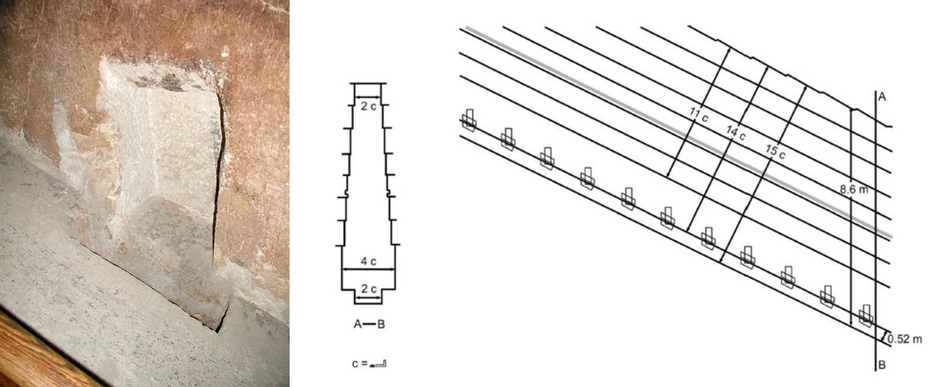
Source of the draw: "Examining The Grand Gallery in The Pyramid of Khufu And its Features" by Luca Miatello in PalArch´s Journal of Achaeology of Egypt/Egyptology, 7(6) (2010)
31.26 The niches of the eastern and wester walls of the Great Pyramid of Giza
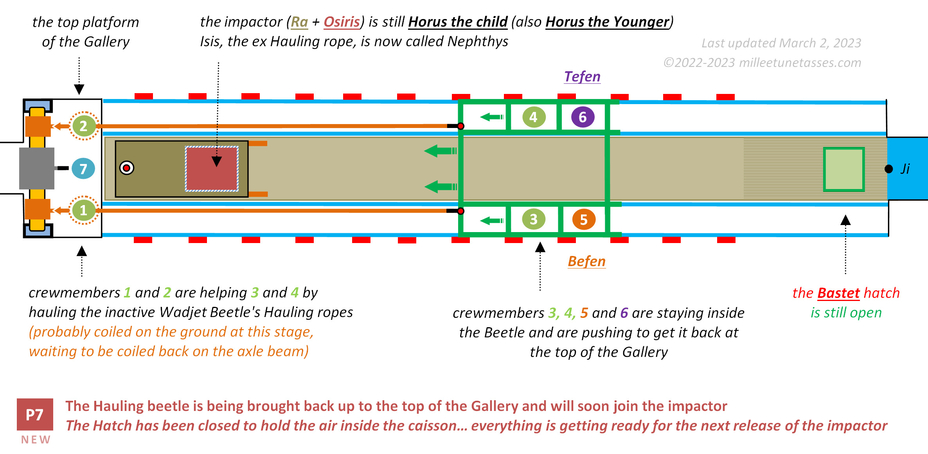
31.27 Operating diagram of the Grand Gallery with seven crewmembers and a six-compartments Hauling beetle, P7
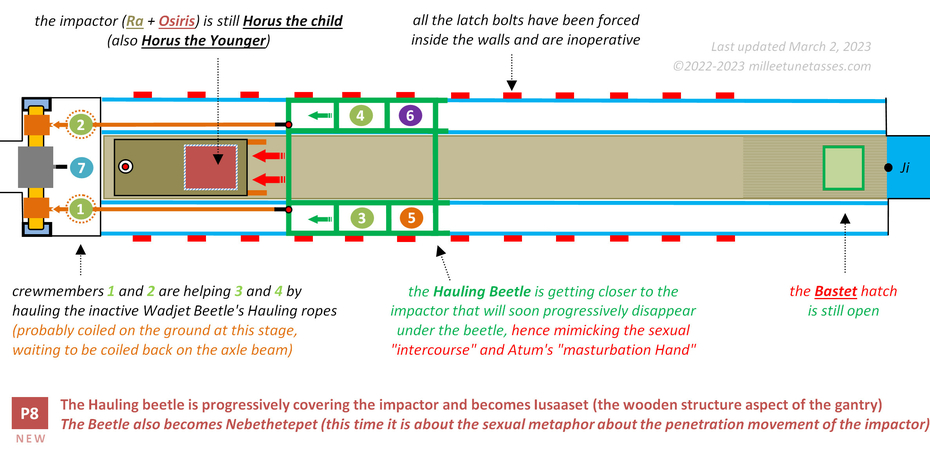
31.28 Operating diagram of the Grand Gallery with seven crewmembers and a six-compartments Hauling beetle, P8
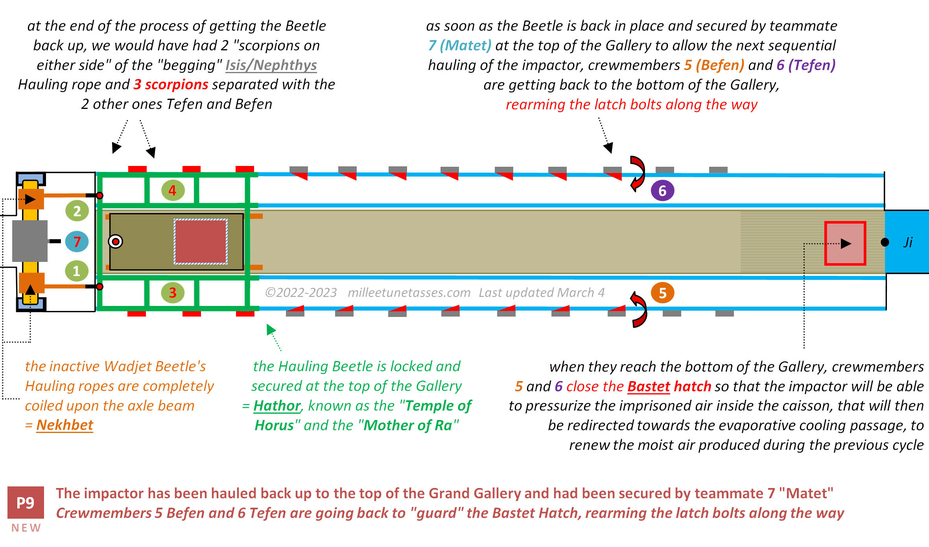
31.29 Operating diagram of the Grand Gallery with seven crewmembers and a six-compartments Hauling beetle, P9
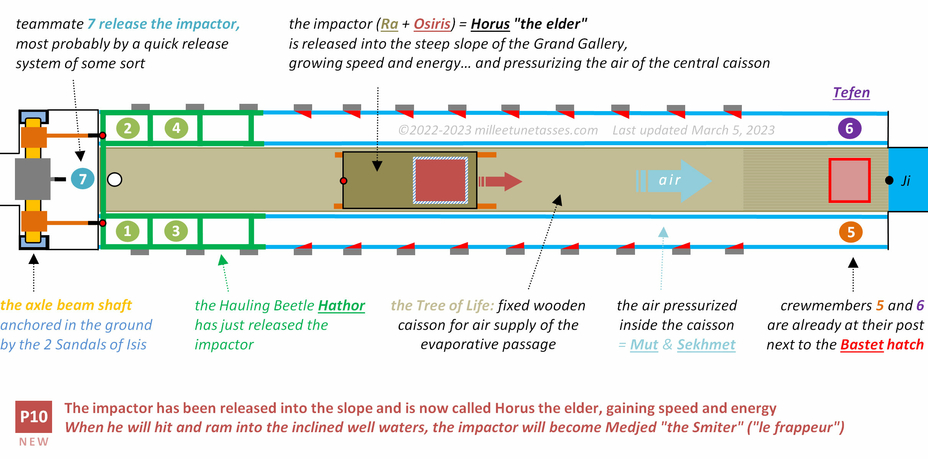
31.30 Operating diagram of the Grand Gallery with seven crewmembers and a six-compartments Hauling beetle, P10
One of the most popular stories concerning Isis is known as Isis and the Seven Scorpions. It relates how, when Horus was an infant and Isis was hiding him in the swamp lands, Serket had seven scorpions keep her company. When Isis went out to beg for food in the nearby towns, three of them - Petet, Tjetet, and Matet - would go before her to make sure the way was safe and Set was not waiting in ambush, two were on either side of her - Mesetet and Mesetetef - and two brought up the rear - Tefen and Befen, who were the most fierce - in case Set chose to attack from behind".
31.31 Why Tefen and Befen were the "most fierce" of the scorpions and ready to face Seth
If Tefen and Befen were "the most fierce" of the seven scorpions and prepared to face Seth (Set), it is because they were both at the bottom of the Grand Gallery when the impactor was released, next to the Bastet hatch. If the Hatch was to fail, there would have been facing pressurized air.
Again, ancient Egyptians glorified the same thing, here it is the air being pressurized in the caisson, in (at least) two major deifications:
• First in Seth, who is about the air facing (or fighting) the fall of the impactor: that is what the famous "Contendings" between Ra and Seth are all about (Section 24.09).
• Second into Sekhmet, who is that same pressurized air, but feared to get out of the central wooden caisson through the Bastet hatch, if this hatch happened to fail (Section 27).
"Horus and Set challenged each other to a boat race, where they each raced in a boat made of stone. Horus and Set agreed, and the race started. But Horus had an edge: his boat was made of wood painted to resemble stone, rather than true stone."
"According to one myth, Apep would hypnotise the sun god and all of his followers, except Set who would repel the serpent by piercing his side with a great spear. In some texts, Apep* would trap the boat of Ra in his massive coils (referred to as sandbanks) or cause the waters of the underworld to flood to overwhelm him." https://ancientegyptonline.co.uk/apep/
* Apep is the glorification of the waters of the inclined well, being pressurized by the fall of the impactor.
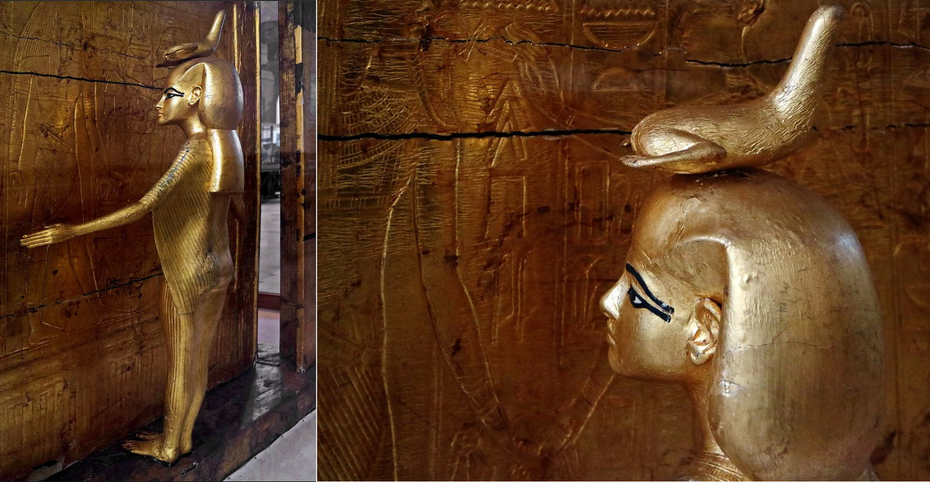
"Guardian statue of the goddess Selket [Serket] from the Tomb of Tutankhamun." Egyptian Museum Cairo, photo by Hans Ollermann 2016. https://www.flickr.com/photos/menesje/29111939073/in/photostream/ and https://www.flickr.com/photos/menesje/29634452671/in/photostream/
31.32 Serket is the Hauling beetle rising the impactor, i.e. giving birth to Horus (associated with air)
"One of the most popular stories concerning Isis is known as Isis and the Seven Scorpions. It relates how, when Horus was an infant and Isis was hiding him in the swamp lands, Serket had seven scorpions keep her company."
The myth about Isis and the seven scorpions is confusing because it could let us think that the scorpions are belonging to Isis herself; but it is not: they belong to Serket.
Serket is the key, and she is actually at the center of the story, because she appears in the myth when Horus "was an infant" who was "hidden in the swamp lands".
What it is describing is the impactor Horus the child hidden in the inclined well (that is Sobek), and waiting to be hauled back up to the top of the Gallery. In order to do that, the Beetle could only be at the top of the Gallery itself.
It means that Serket is the Hauling beetle ready to process, ready to haul the impactor out of the darkness of the inclined well waters; and that is the birth of Horus.
In other words, Serket is the Beetle giving birth to Horus (Horus the child), from the top of the Grand Gallery.
31.33 The Serket "Who causes the Throat to breathe" metaphor of the pressurized air forced though the central caisson
We'll see farther in this Section that the Beetle had been also associated with another goddess, Neith, in the same position that Serket, but instead of being associated with Horus, Neith is associated with Ra.
The big difference between Horus and Ra, is their respective "associate element": when Horus is associated with the air (Horus is often represented in a hawk), Ra is often associated with water (the barque of Ra).
It is most probably because of this association with the air, that Serket has been described as the one "who causes the throat to breathe". Of course, the throat is all about the central caisson of the Grand Gallery.
"She [Serket] is associated with healing, magic, and protection, and her name means "She Who Causes the Throat to Breathe". https://www.worldhistory.org/Serket/
I need at this time to emphasize one more time how crucial was the role of the central caisson for the entire operating of the Great Pyramid: if you don't get rid of the moist air produced during each cycle, the evaporative cooling stops right away. The evaporative cooling needs dry air to work, so that as much water can be forced into it.
Without the caisson, there wouldn't be any "cleaning" of that moist air.
The impactor worked inside the caisson just like a bicycle pump: it pressurized the air that was forced through the wooden structure, and then forced towards the evaporative cooling passage. In some ways, the central caisson looked like a throat, hence the "She Who Causes the Throat to Breathe" metaphor, about Serket (the Hauling beetle releasing the impactor).
By releasing the impactor in the central caisson, Serket caused the "throat" to breathe.

Figures of Horus from the Louvre Museum, Paris. DUT162: https://collections.louvre.fr/ark:/53355/cl010409963 and E3752: https://collections.louvre.fr/ark:/53355/cl010006611
Evaporative cooling applications webpage screenshot : AquaFog® from Jaybird Manufacturing Inc (Pennsylvania, USA) : https://jaybird-mfg.com/applications/evaporative-cooling/
31.34 Serket... and the "Refreshment of the Gods" complex of pharaoh Djoser
The fact that ancient Egyptians were really creating cold by mastering basic laws of physics, has already been mentioned in this work: the very first pyramid complex built by pharaoh Djoser was indeed called "the Refreshment of the Gods".
"Of course, Imhotep is most famous as the builder of Djoser’s unprecedented step pyramid complex, called the “The Refreshment of the Gods.” Imhotep designed this complex on a scale that surpassed everything achieved by his predecessors." https://arce.org/resource/search-imhotep-tomb-architect-turned-god-remains-mystery/
If this "Refreshment of the Gods" translation from the ancient Egyptian language, would most probably gain in being called "the Cooling of the Gods", the "Refresh" word can be directly linked to Serket herself:
"Qebehsenuef (Qbḥ-sn.w⸗f) was the falcon-headed son of Horus, and protected the intestines of the deceased. He was in turn protected by the goddess Serket. It appears that his role was to refresh the dead person, and his name means literally "he who libates his siblings". Horus commands him, "Come refresh my father; betake yourself to him in your name of Qebehsenuef. You have come that you may make coolness for him after you ... " https://en.wikipedia.org/wiki/Four_sons_of_Horus
"You have come that you may make coolness for him after you": is a perfect illustration of "the Pyramids of the Cold".
31.35 When Osiris and Horus are directly associated with "cooling" and "cold water"
"Osiris N, take this fresh water, cooled for you by Horus, in your name of He-who-is-come-from-the-fresh-water". […] "The most complete ancient work in existence of the myth of Osiris which we know is that of Plutarch, in his 'De Iside et Osiride'. We know the stratagem used by Seth and his associates, and we know how the conspirator, having locked Osiris precisely by guile in a chest made to his measurements, threw it into the sea, an episode which Plutarch is the only one to relate, began the mourning and the quest of Isis. […] Osiris is designated as the one who had been "put in a chest (deben), in a box and in a bag".Nadine GUILHOU: Les deux morts d'Osiris, d'après les textes des Pyramides.
Extracted from the magazine "Egypte", N°10, August 1998: https://www.osirisnet.net/dieux/osiris/e_osiris_03.htm
"But I am parched with thirst and I perish. Give me quickly the cold water flowing forth from the Lake of Memory".
Delia, D. (1992). The Refreshing Water of Osiris, page 189. Journal of the American Research Center in Egypt, 29, 181–190. https://doi.org/10.2307/40000492
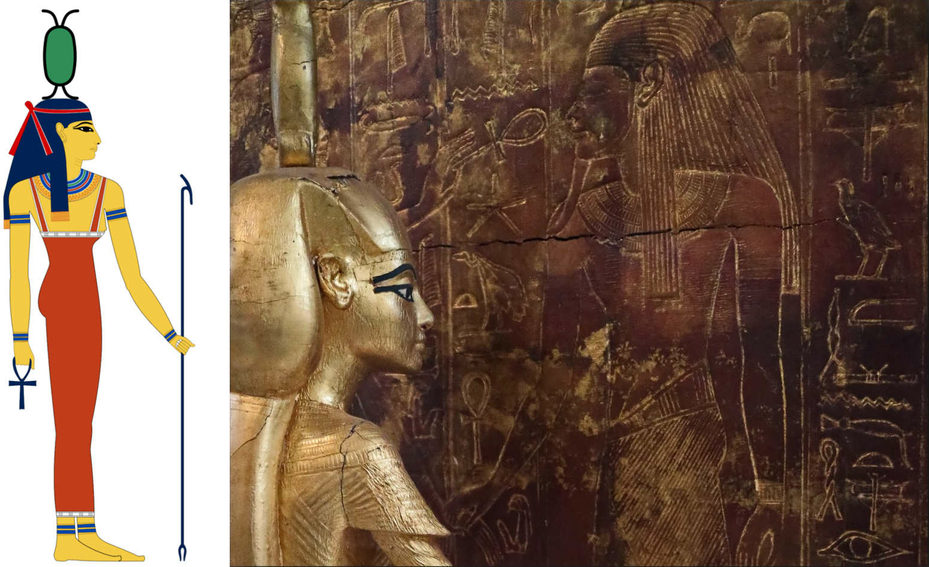
Draw of goddess Neith by Jeff Dahl: https://en.wikipedia.org/wiki/Neith#/media/File:Neith.svg
"Guardian statue of the goddess Neith from the Tomb of Tutankhamun. Egyptian Museum Cairo, photo by Hans Ollermann 2016. https://www.flickr.com/photos/menesje/29483236590/in/photostream/
31.36 Neith is the last goddess of the famous four golden statues protecting Tutankhamun's gilded shrine
In the following excerpt about Serket, another goddess is brought to our attention: Neith, the fourth goddess who was protecting the gilded shrine of Tutankhamun.
We've already deciphered Isis (the active Hauling rope), Nephthys (the inactive Hauling rope) and Serket (the Hauling Beetle releasing the impactor seen as Ra because of the endless cycle of the sun metaphor), and now we have the last one of the goddesses protecting the shrine: Neith.
"She [Serket] is depicted as nursing the kings of Egypt in the Pyramid Texts, which date to the Old Kingdom (2613-2181 BCE), and one of the protective spells from those texts - known as PT 1375 - reads, "My mother is Isis, my nurse is Nephthys...Neith is behind me, and Serket is before me" (Wilkingson, 233). These four goddesses would later be represented famously in Tutankhamun's tomb on the canopic chest and as gold statues protecting the gilded shrine." […] There is no evidence of temples to Serket in any region of Egypt suggesting to some scholars that she either never had any or, more likely, that she was absorbed into the figures of other deities such as Hathor or Neith, who are equally ancient. https://www.worldhistory.org/Serket/
31.37 Neith is also about the Beetle releasing the impactor seen as a physical object (not about its operating cycle)
The following excerpts are giving the meaning of Neith. Just like Serket was representing the release of the impactor as a metaphoric representation of the endless cycle of the Sun, Neith is actually exactly that same impactor, and in the same exact position, but not about the cycle of the Sun anymore: Neith is about the physical aspect of the impactor, its force, its power (Horus), the way it looked (the wooden part Ra and Sobek floating inside the well).
When Neith is described as "either" the mother of Ra, "either" the mother of Sobek, she is actually the mother of both at the same time, because as we've already seen in previous Section 30; the impactor was seen as Ra (and Horus the Elder) when descending the Grand Gallery, and as Sobek when floating in the inclined well after the impact.
"In the form of a cow, she [Neith] was linked to both Nut and Hathor, and in late dynastic times she was regarded as a form of Hathor". https://ancientegyptonline.co.uk/neith/
"Sometimes Neith was pictured as a woman nursing a baby crocodile, and she then was addressed with the title, "Nurse of Crocodiles", reflecting a southern provincial mythology in Upper Egypt that she served as either the mother of the crocodile god, Sobek. As the mother of Ra, in her Mehet-Weret form, she was sometimes described as the "Great Cow who gave birth to Ra". As a maternal figure (beyond being the birth-mother of the sun-god Ra), Neith is associated with Sobek as her son (as early as the Pyramid Texts)". https://en.wikipedia.org/wiki/Neith
"Neith was associated with Anubis and Wepwawet (Upuaut), because of her epithet “Opener of the Ways”. She was also one of the four goddesses (along with Isis, Nephthys, and Serqet/Selket) who protected the deceased and the canopic jars (which were topped by the four sons of Horus). Neith guarded the east side of the sarcophagus and protected Duamutef (the the jackal-headed god) as he watched over the stomach. Neith was usually depicted as a woman wearing the Red Crown of Lower Egypt, but was occasionally depicted as a cow in connection with her role as the mother of Ra (linking her with Hathor, Hesat, and Bat). Her name links her with the crown of Lower Egypt which was known as “nt” . However, her name is also linked to the word for weaving (‘ntt’) and to one of the words used for water (“nt”). When she is referred to as the creator of the world her name is written using the hieroglyph of an ejaculating phallus, indicating that she was considered as an androgynous creator". Copyright Jenny Hill 2010: https://ancientegyptonline.co.uk/neith/
31.38 Neith is indeed about "opening", "releasing" and "shooting"
Most probably the epithet "the Opener of Paths" attributed to Neith, has to be associated with the Serket's "Who causes the Throat to breathe" metaphor: they are both describing the fall of the impactor in the caisson, pressurizing and pushing the air in front of him.
And there is another metaphor also used about Neith, that is still depicting that same powerful movement of the impactor in the caisson: that is the "arrow" metaphor.
It is not the first time we've seen the "arrow" metaphor, it has already been seen in the Satis and Anuket deciphering (Elephantine triad Section): the arrow shot from the bow was about the part of the biosand filter valve which was regulating the fixed part of the valve; and here it is about the moving impactor leaving the Hauling beetle and speeding in the caisson.
"References to Neith as the "Opener of Paths" occurs in Dynasty Four through Dynasty Six, and Neith is seen in the titles of women serving as priestesses of the goddess. Such epithets include: "Priestess of Neith who opens all the (path)ways", "Priestess of Neith who opens the good pathways", "Priestess of Neith who opens the way in all her places". […] Since Neith also was goddess of war, she thus had an additional association with death: in this function, she shot her arrows into the enemies of the dead". https://en.wikipedia.org/wiki/Neith
31.39 From the arrow metaphor to the endless weaving metaphor
The arrow metaphor is good, it describes perfectly the movement of the impactor leaving the Beetle, but it doesn't include the endless part of the operating of that impactor; but there is another metaphor which does: the weaving metaphor, where the endless up and down movement of the impactor has been compared to the endless left to right movement of the shuttle used in a loom.
"As the goddess of creation and weaving, she was said to reweave the world on her loom daily. An interior wall of the temple at Esna records an account of creation in which Neith brings forth the Nun, the first land, from the primeval waters. All that she conceived in her heart comes into being". https://en.wikipedia.org/wiki/Neith
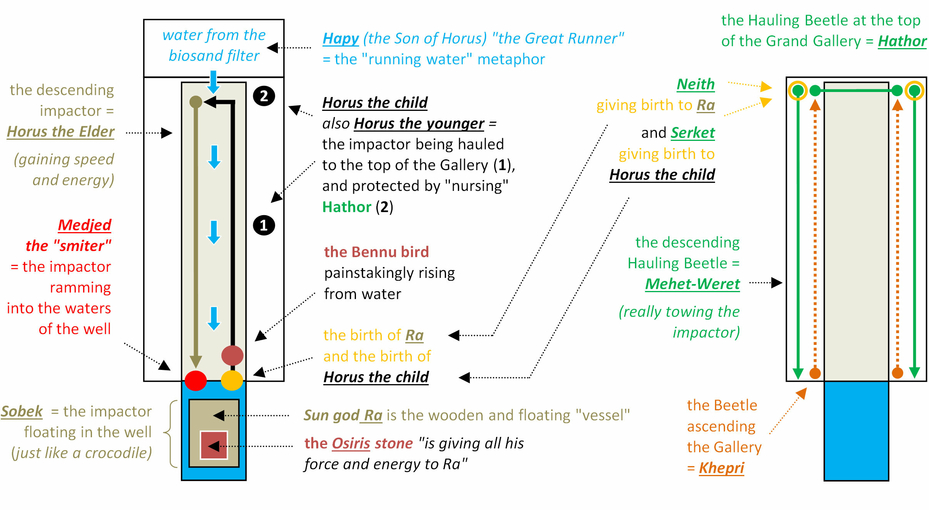
31.40 When Serket is the Hauling beetle releasing the impactor in reference to the birth of Horus, Neith is about the same thing but in reference to the birth of Ra
What is beautiful is that the ancient Egyptians gave two different names to the Beetle at the exact moment when the impactor is released: the first one is regarding to Ra and the endless cycle of the day, and the Beetle is then called Neith; the second one is regarding to all the ramming power of Horus and, and the Beetle is then seen as Serket.
About Serket / Horus : "Serket is sometimes included in the story [the Osiris myth] at this point in her role as protector of the innocent. Isis has a difficult labor and gives birth to Horus in the swamps of the Delta. Serket presides over the birth keeping venomous scorpions and snakes away from the new mother and child. This part of the story would later be cited in Serket's role as protector of women in childbirth and of mothers and children. After Horus' birth, Isis had to continue to hide in the marshes from Set and only went out at night for food. At these times, Serket guarded the baby and sent her scorpions with Isis as her bodyguard". https://www.worldhistory.org/Serket/
About Neith / Ra: "As the mother of Ra, in her Mehet-Weret form, she was sometimes described as the "Great Cow who gave birth to Ra". https://en.wikipedia.org/wiki/Neith
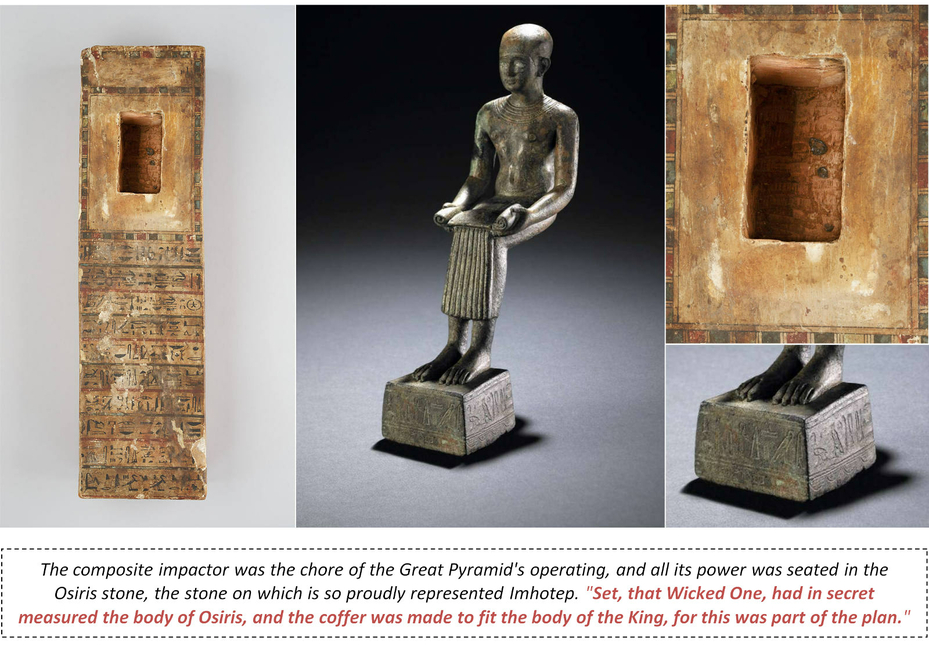
Wooden base of a Ptah-Sokar-Osiris figure at the MET, dedicated to a temple musician named Ihet; it is inscribed with offering prayers and texts glorifying the gods : https://www.metmuseum.org/art/collection/search/553823
Bronze seated figure of Imhotep at the British Museum: https://www.britishmuseum.org/collection/object/Y_EA40666
31.41 The Osiris myth and the coffin that perfectly fits his body
Just as a reminder, there are some excerpts of the Osiris myth, where is "explained" the chore of the operation of the Great Pyramid: the composite nature of the impactor, designed to get to water.
What is very interesting in this myth, is that it is clearly suggested that first was designed the Osiris stone, and only then, the wooden vessel for the stone had been crafted: "Set, that Wicked One, had in secret measured the body of Osiris, and the coffer was made to fit the body of the King, for this was part of the plan."
What it means is that the ancient Egyptian engineers first had to determine what power they needed to pressurize the waters of the well to get the perfect fog of microdroplets in the evaporative cooling passage; and only then they were able to design the wooden coffin, then maybe the gutter and all the Grand Gallery's design: the slope, the length, etc.
Excerpts are from Sacred Texts: https://www.sacred-texts.com/egy/ael/ael08.htm#page_41
"Set hated his brother Osiris, and he gathered to himself seventy-two conspirators […]. And they made a plan that when Osiris returned they should kill him and place Set on the throne; but they hid their plans, and with smiling faces went out to meet Osiris when he re-entered Egypt in triumph."
"In secret they met again and again, in secret also they prepared a coffer made of costly wood painted and decorated with rich designs and glowing colours […]. Set, that Wicked One, had in secret measured the body of Osiris, and the coffer was made to fit the body of the King, for this was part of the plan."
"When all was ready, Set bade his brother and the seventy-two conspirators to a feast in his great banqueting-hall. […] Then Set stood up in his place and said, "He who lies down in this coffer and whom it fits, to that man I will give it." His words were sweet as honey, but in his heart was the bitterness of evil."
"One after one, the conspirators lay down in the coffer with jests and laughter; for one it was too long, and for another it was too short, and for a third it was too wide, and for a fourth too narrow. Then came Osiris to take his turn, and he, all unsuspecting, lay down in it. At once the conspirators seized the lid and clapped it on; some nailed it firmly in its place, while others poured molten lead into all the openings lest he should breathe and live. Thus died the great Osiris."
"The conspirators lifted the chest, which was now a coffin, and carried it to the river-bank. They flung it far into the water, and Hapi the Nile-god caught it and carried it upon his stream to the sea; the Great Green Waters received it and the waves bore it to Byblos and lifted it into a tamarisk-tree that grew by the shore."
Sagi
Can't realize how the hatch is needed for the re attachment of the central rope.
as I see it the extended wooden board connecting the lower part of the grand gallery
with the inclined well mouth is in a straight line, so to re attach the rope
the crewmember only needs to slide down the board.
When opened, the hatch leads to the horizontal corridor, doesn't it ?
Bruno
Hello Sagi,
The hatch isn't on the ramp but on the caisson that is covering that ramp, at the very bottom of the Gallery (look at P4 Side View): in order to create and use pressurized air, the central caisson had to function exactly like a bicycle pump. The caisson was closed and completely airtight, from top to bottom, the only access to its interior was the Bastet hatch at the bottom of the Gallery, near the mouth of the inclined well.
Poster un commentaire
